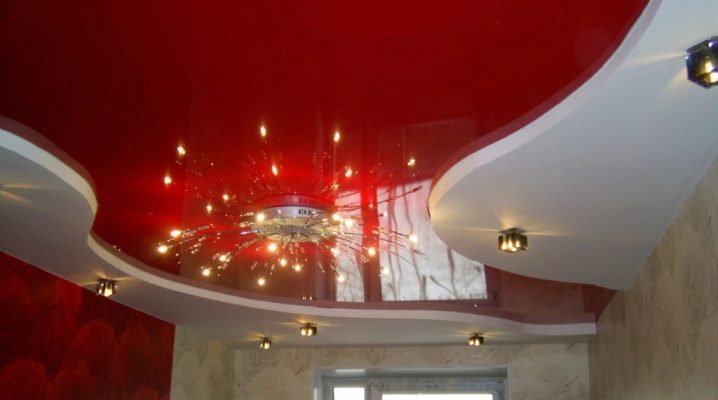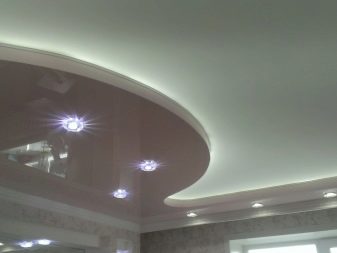Features of the process of repairing stretch ceilings

Ceiling decoration assumes its alignment. For such purposes, several practical approaches are used today, among which one of the most popular is the introduction of tension materials. The operation of ceiling films is very often accompanied by their damage, which requires high-quality and quick restoration.


Peculiarities
Stretch ceilings are a thin polymer or fabric film that is suspended horizontally on a special frame. Such elements are made from various materials, which allows them to be divided into the following types:
- Tissue... The composition of this product may vary depending on the manufacturer. But a distinctive feature of this option is the presence of pores that can allow air to pass through, therefore, fabric ceilings are used in bedrooms or children's rooms, that is, where optimal air exchange is needed. The material tolerates temperature extremes well, and it is also more difficult to accidentally cut it. Manufacturing technology allows you to get canvases of almost any size.
Among the disadvantages are the minimum plasticity, as well as the rapid accumulation of dust. The fabric ceiling must be constantly monitored.

- Polymer... The main component of the product is polyvinyl chloride and its combinations. The ceiling is a thin film. The width of one layer cannot exceed 3 m, therefore, for installation in large rooms, several elements are simply soldered together, which leads to the formation of a visible seam.

The advantages of this product are:
- durability and versatile design;
- the ability to paint polymers in almost any color;
- the top layer does not accumulate electrostatic energy, which, in turn, prevents dust from settling on the surface;


- the polymer stretches well, which prevents accidental flooding of the apartment by neighbors from above;
- the strength of the material depends on the temperature;
- the product is easy enough to cut;
- almost any sharp object can damage the material.


Operating rules
Repair of stretch ceilings is a rather complicated operation that cannot always be performed. But the practicality and versatility of these models today replaces suspended structures made of plasterboard. To exclude damage to the canvases, when operating tensioning models, you should adhere to some recommendations:
- It is necessary to minimize the risk of mechanical impact on the canvas. This applies to both polymer and fabric ceilings. If this is not done, then sooner or later the material can be punctured, which will lead to a complete replacement of the entire product or complex manipulations during repair.

- If a person does not have experience with such substances, then all operations for installing lamps, as well as removing leaks, should be trusted only by specialists.
- Ceilings are washed only with special solutions. It is undesirable to use aggressive mixtures in apartments, since this approach is not only harmful to the material, but also affects the health of the inhabitants of the house.

- Polymers can be used only at temperatures no higher than 70 degrees. If you heat the canvas to such values, then it will simply melt or lose its elasticity. Therefore, all lamps installed in the room must be protected by special covers or located at a certain distance from the fabric. Also, do not allow hot water to get on these elements.
- In a room with a stretch ceiling, a positive temperature must be maintained. It is not recommended to operate materials with negative values, since the substance loses its physical properties and becomes brittle and easily damaged.


Damage types
Stretch ceilings can be easily damaged, as they are operated under significant tension. This in turn reduces the effort required to break the bonds between molecules. There are several types of damage that can be roughly divided into groups.
- Cuts and punctures... The formation of such damage occurs when a sharp object is accidentally pressed against the surface of the material. In the case of plastic models, you can pierce the substance with any sharp object: a needle or an acute angle on furniture.


- Sagging... These defects can occur due to reasons such as poor quality material or water ingress. Many patterns begin to sag over time, which indicates that the fabric of the ceiling structure has lost its elasticity and is no longer suitable. If the ceiling does not burst in this case, you can try to repair it, but this is not always possible.
- Break along the seam or at the point of contact with the profile... The first type of damage is relatively rare. In most cases, this is due to poor quality supplied material that does not withstand the load. A rupture at the points of abutment to the profile occurs when the fabric component is incorrectly installed or after its final aging.

- Reflow... This problem is caused by fixtures or ceiling lamps that heat the structure to high temperatures. To prevent the lighting device from burning through the material, it should be mounted on the basis of special protective elements. Additionally, it is necessary to minimize the risk of these components joining during operation.

Subtleties of repair
The restoration of stretch ceilings is a rather complicated operation that is not always feasible. Below are some technologies that allow you to repair products with your own hands without involving specialists of this profile.
Repairing cuts or punctures
Such damage suggests the formation of a non-standard hole on the surface. Over time, it can simply creep in different directions.

Before making repairs, it is important to determine the nature of the damage. If after a puncture a small a hole with a radius of up to 2 mm, then you can try to fill it with glue... It will simply tighten the material, forming a kind of plastic patch.
Small holes that are less than 10 cm long should also be repaired.... To connect the torn ends on a glossy ceiling, cut out a patch from the same material and glue it from the inside of the layer. At the same time, it is important to combine the opposite sides of the hole as carefully as possible.


If a person is not sure that he will be able to fix the patch from the inside of the canvas, then it can be glued on the outside. In order not to spoil the design of the room, it is recommended to use decorative patches for such purposes. A certain pattern is applied to the surface of such an element, which will perfectly fit into the interior of the room.
An alternative to patches is to install a pendant light... To do this, a metal ring is first glued over the hole, which will prevent the polymer from spreading. Then, inside it, the remnants of the material are carefully cut out and the lamp is inserted. This option can be used only when such attributes are already on the ceiling. If there is only one, then this style will be impractical.

When the cut is close enough to the baguette, you can try to drag the material. But such operations are carried out only by experienced specialists.... Small incisions in fabric canvases can be simply sewn up with thread.To do this, it is important to match it to the color of the base coat. It is worth paying attention to the fact that only small defects are susceptible to such an effect.
Flooding stretch
Situations like this are quite common. It should be understood that if the polymer ceiling was exposed to hot water (temperature above 70 degrees), then it will not be possible to restore it. He will no longer be able to return to the desired shape, and therefore it will need to be completely replaced.

If the material is stretched under the influence of cold liquid, then such ceilings can be repaired. In this case, before starting work, the apartment or riser is completely disconnected from the electricity. After that, the liquid must be drained.
It is worth paying attention to the fact that you should not make a hole, as the large weight of the water will simply tear the fabric in half. It is better to use the hole of the pendant lamp for draining.to be dismantled first. An alternative hole can be the edge of the canvas, which needs to be released from the latches.
When everything is ready, you should gently move the water to the hole. You should not try to do it abruptly or in parts. It is better that the entire volume gradually moves in the desired direction.


If you distribute the flow of water, then a small amount of it may remain in the corners under the material, and it will no longer be possible to expel water from there. After draining the liquid, allow the surface to dry. This can take several days.
Upon completion of this preparation, the fabric is gradually warmed up with a hair dryer. In this case, the polymer will again acquire elasticity and shape, which will allow it to continue to be used further.

Burning
This kind of damage is not very common. The repair algorithm is very similar to the repair technology for cuts or punctures.
If the hole is small, then finishing the hole with a heat-resistant ring is the best option. Initially, it is glued to the ceiling, and after drying, all the insides are cut out.

Unauthorized stretching
It is rather difficult to fix such a defect on your own, since for this you need to completely remove the canvas and pull it again.
Another problem is that not all fasteners allow dismantling. Only harpoon profiles are suitable for such purposes, allowing you to pull out the material and fix it again.

Tips & Tricks
Repair work related to stretch ceilings requires accuracy and care. Therefore, in order to solve such problems efficiently and quickly, it is advisable to adhere to some recommendations:
- If any cuts occur on the canvas, the possibility of further creep of the satin ceiling should be excluded as quickly as possible. To do this, masking tape is carefully glued along the edges of the hole, which will hold the material until it is completely repaired.
- All reconstruction operations should be carried out at the initial stage. It is necessary to use only high-quality repair materials that can withstand the load without damaging the material.
- If the cause of the breakdown is a defect in the product or its incorrect installation, you should immediately contact the company that installed and sold such products. In most cases, they repair such defects at their own expense.
- It is important to carry out all operations with canvases very carefully so as not to destroy its structure even further.


All operations for the reconstruction of canvases must be entrusted to a team of experienced specialists who know how to quickly and efficiently solve a specific problem. This approach will reduce the risk of further tissue damage and guarantee the long-term operation of the product for a long time.


A stretch ceiling repair option is presented in the following video.













The comment was sent successfully.